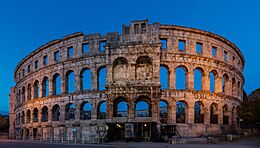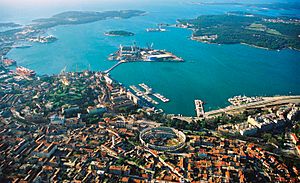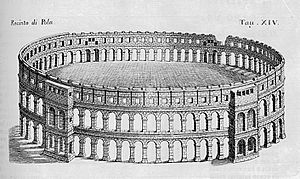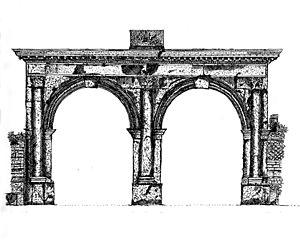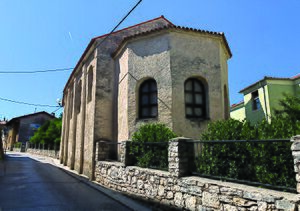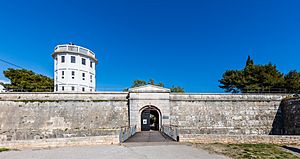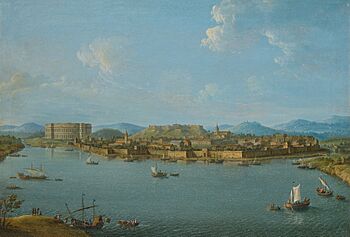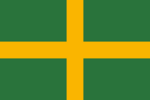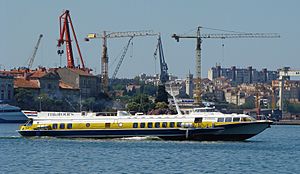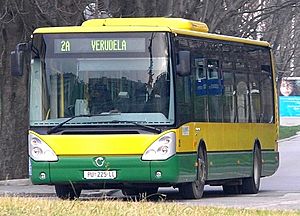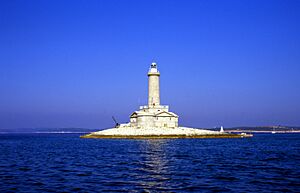Pula facts for kids
Quick facts for kids
Pula
Pola
|
|||
|---|---|---|---|
| Grad Pula / Città di Pola | |||
|
Clockwise, from top: Pula Arena; Arch of the Sergii; Verudela marina; Pula Arena interior; Church of Saint Anthony; Town Hall and the Temple of Augustus
|
|||
|
|||
| Country | |||
| County | |||
| Area | |||
| • City | 53.8 km2 (20.8 sq mi) | ||
| • Land | 41.59 km2 (16.06 sq mi) | ||
| • Urban | 53.8 km2 (20.8 sq mi) | ||
| Elevation | 30 m (100 ft) | ||
| Population
(2021)
|
|||
| • City | 52,220 | ||
| • Density | 970.6/km2 (2,513.9/sq mi) | ||
| • Urban | 52,220 | ||
| • Urban density | 970.6/km2 (2,513.9/sq mi) | ||
| Time zone | UTC+1 (CET) | ||
| • Summer (DST) | UTC+2 (CEST) | ||
| Postal code |
HR-52 100
|
||
| Area code | +385 52 | ||
| Vehicle registration | PU | ||
Pula (also known as Pola) is the largest city in Istria County, Croatia. It is the seventh-largest city in the country. Pula is located at the southern tip of the Istrian peninsula in northwestern Croatia. In 2021, about 52,220 people lived there.
The city is famous for its many old Roman buildings. The most well-known is the Pula Arena, which is one of the best-preserved Roman amphitheaters. Pula has a long history of making wine, fishing, building ships, and welcoming tourists. It was the main city in Istria from ancient Roman times until 1991.
Contents
Discovering Pula's Past
Pula's Earliest History
Scientists have found signs of early humans, called Homo erectus, living near Pula about one million years ago. This was in a cave called Šandalja. Pottery from the Neolithic period (6000–2000 BC) shows that people settled around Pula a very long time ago.
During the Bronze Age (1800–1000 BC), people in Istria built new types of settlements. These were called 'gradine', which were like forts on hilltops. Many old bone tools and bronze items have been found in the Pula area from this time. These finds connect Istria to places along the Danube River. The people living in Istria during the Bronze Age are known as Proto Illyrians.
We also know that Greek culture had an influence here. Greek pottery and a piece of a statue of Apollo have been found. An old Greek story says that the city of Polai was founded by the Colchians. They were chasing Jason and Medea who had stolen the golden fleece. When they couldn't catch them, the Colchians settled in this place and called it Polai, meaning "city of refuge".
Pula in Ancient Roman Times
In ancient times, the Histri tribe lived in Pula. They were either a Venetic or Illyrian group. Writers like Strabo and Pomponius Mela also said that Colchians lived here.
The Istrian peninsula became part of the Roman Empire in 177 BC. This started a period where the Roman way of life became common. Pula became a Roman colony between 46 and 45 BC, thanks to Julius Caesar. The city grew a lot and had about 30,000 people at its busiest. It became an important Roman port.
During a civil war in 42 BC, Pula supported Cassius, one of Caesar's assassins. After Octavian won, the city was destroyed. But it was quickly rebuilt at the request of Octavian's daughter, Iulia. It was then called Colonia Pietas Iulia Pola Pollentia Herculanea. Many grand Roman buildings were constructed, and some are still standing today.
Famous Roman Buildings in Pula
A huge amphitheatre, the Pula Arena, was built between 27 BC and 68 AD. Much of it is still standing. The Romans also built water and sewage systems for the city. They protected Pula with a wall that had ten gates. Some of these gates still exist:
- The Arch of the Sergii, a triumphal arch.
- The Gate of Hercules, which has the names of the city's founders carved into it.
- The Twin Gates.
During the rule of Emperor Septimius Severus, the city's name changed to "Res Publica Polensis". Pula was also where two Roman leaders, Crispus and Constantius Gallus, were executed in 326 AD and 354 AD. By 425 AD, Pula became an important religious center with several churches.
Pula in the Middle Ages
After the Western Roman Empire fell, the city was attacked by the Ostrogoths. Pula was almost completely destroyed in 476 AD. The Ostrogoths ruled from 493 to 538 AD. After them, Pula became part of the Exarchate of Ravenna (540–751). During this time, Pula became a major port for the Byzantine navy. The Basilica of Saint Mary Formosa was built in the 6th century.
From 788 AD, Pula was ruled by the Frankish Empire under Charlemagne. The feudal system was introduced. Pula became part of the Kingdom of Italy. In 1148, the Venetians took the city. In 1150, Pula officially became part of the Republic of Venice. For many centuries, Pula's future was linked to Venice.
Pula was attacked and taken by the Pisans in 1192, but Venice quickly got it back. In 1243, Venice sacked Pula because the city sided with Pisa. Pula was destroyed again in 1267 and in 1397. This was when the Genoese defeated the Venetians in a sea battle. Pula slowly began to decline. This decline was made worse by fights between local families and the struggle between Venice and Genoa for control of the city. Venice finally held Pula from 1331 until 1797.
The famous Italian poet Dante Alighieri visited Pula. He wrote about it in his book Divine Comedy. He described Pula as marking the end of Italy.
Pula Under Different Rulers
The Venetians ruled Pula from 1331 to 1797. During these centuries, Pula was attacked by the Genoese, the Hungarian army, and the Habsburgs. Many nearby towns were destroyed. Besides wars, diseases like the plague, malaria, and typhoid also harmed the city. By the 1750s, only about 3,000 people lived in the old city.
When the Venetian Republic fell in 1797, Pula became part of the Habsburg monarchy. Napoleon's French army invaded in 1805. Pula was then part of Napoleon's French Empire for a while.
In 1813, Pula became part of the Austrian Empire again. Under Austrian rule, Pula became successful once more. Its large natural harbor became Austria's main naval base. It also became a major center for shipbuilding. The island of Brioni (now Brijuni) became a summer vacation spot for the Austrian royal family. During World War I, Pula's port was the main base for the Austro-Hungarian navy. Many people in Pula spoke Italian at this time.
After World War I, in 1918, Pula became part of Italy. It was the capital of the Province of Pola. The city's population dropped because the Austro-Hungarian military and government left. Under the Italian Fascist government, non-Italians, especially Croatians, faced harsh treatment. Many left the city and moved to the new country of Yugoslavia.
When Fascist Italy collapsed in 1943, the German army took over Pula. The city was bombed many times by the Allies from 1942 to 1944. Towards the end of the war, people suspected of helping the Axis were arrested and executed.
Pula After World War II

After World War II, many Istrian Italians living in Pula moved to Italy. For two years after 1945, Pula was managed by the Allied Military Government. Pula officially became part of SFR Yugoslavia on September 15, 1947. It was part of the Socialist Republic of Croatia.
At first, Pula's population was mostly Italian. But between 1946 and 1947, most Italians left for Italy. The city's Croatian name, Pula, then became the official name. Today, Pula is officially bilingual, meaning both Croatian and Italian are official languages. Since Yugoslavia broke apart in 1991, Pula has been part of the Republic of Croatia.
Pula's Location and Weather
| Weather chart for Pula (Pula, City of Pula) | |||||||||||||||||||||||||||||||||||||||||||||||
|---|---|---|---|---|---|---|---|---|---|---|---|---|---|---|---|---|---|---|---|---|---|---|---|---|---|---|---|---|---|---|---|---|---|---|---|---|---|---|---|---|---|---|---|---|---|---|---|
| J | F | M | A | M | J | J | A | S | O | N | D | ||||||||||||||||||||||||||||||||||||
|
78
10
2
|
64
10
2
|
65
13
4
|
70
16
8
|
56
21
12
|
53
25
16
|
48
28
18
|
75
28
18
|
85
24
15
|
85
20
12
|
80
14
7
|
112
10
4
|
||||||||||||||||||||||||||||||||||||
| temperatures in °C precipitation totals in mm source: EuroWeather |
|||||||||||||||||||||||||||||||||||||||||||||||
|
Imperial conversion
|
|||||||||||||||||||||||||||||||||||||||||||||||
Pula is built on and around seven hills. It is located inside a wide bay with a well-protected port. The port is open to the northwest and has two entrances.
Pula covers about 5,165 hectares (12,763 acres). About 4,159 hectares (10,277 acres) are land, and 1,015 hectares (2,508 acres) are sea.
The city has a humid subtropical climate. This means it has hot, humid summers and mild winters. The highest average air temperature is 23°C (73°F) in July and August. The lowest average is 6°C (43°F) in January and February. Temperatures above 10°C (50°F) last for more than 240 days a year.
Two main winds affect Pula:
- The bora brings cold, clear weather from the north in winter.
- The Sirocco brings rain from the south in summer.
- The 'Maestral' is a summer breeze that blows from the land towards the sea.
Pula is known for its mild climate and calm sea. It gets about 2,316 hours of sunshine each year. The average air temperature is 13.7°C (56.7°F). The sea temperature ranges from 7°C (45°F) to 26°C (79°F).
| Climate data for Pula | |||||||||||||
|---|---|---|---|---|---|---|---|---|---|---|---|---|---|
| Month | Jan | Feb | Mar | Apr | May | Jun | Jul | Aug | Sep | Oct | Nov | Dec | Year |
| Mean daily maximum °C (°F) | 10 (50) |
10 (50) |
13 (55) |
16 (61) |
21 (70) |
25 (77) |
28 (82) |
28 (82) |
24 (75) |
20 (68) |
14 (57) |
10 (50) |
18 (65) |
| Daily mean °C (°F) | 6 (43) |
6 (43) |
9 (48) |
12 (54) |
17 (63) |
21 (70) |
23 (73) |
23 (73) |
20 (68) |
16 (61) |
11 (52) |
7 (45) |
14 (58) |
| Mean daily minimum °C (°F) | 2 (36) |
2 (36) |
4 (39) |
8 (46) |
12 (54) |
16 (61) |
18 (64) |
18 (64) |
15 (59) |
12 (54) |
7 (45) |
4 (39) |
10 (50) |
| Average rainfall mm (inches) | 78 (3.1) |
64 (2.5) |
65 (2.6) |
70 (2.8) |
56 (2.2) |
53 (2.1) |
48 (1.9) |
75 (3.0) |
85 (3.3) |
85 (3.3) |
80 (3.1) |
112 (4.4) |
871 (34.3) |
| Average rainy days | 12 | 12 | 12 | 13 | 13 | 13 | 10 | 11 | 11 | 12 | 13 | 13 | 145 |
| Mean daily sunshine hours | 3 | 4 | 5 | 6 | 8 | 9 | 10 | 9 | 7 | 5 | 3 | 3 | 6 |
| Percent possible sunshine | 33 | 40 | 42 | 43 | 53 | 56 | 67 | 64 | 58 | 45 | 30 | 33 | 47 |
| Source 1: EuroWeather | |||||||||||||
| Source 2: Weather Atlas (sunshine data) | |||||||||||||
| Climate data for Pula | |||||||||||||
|---|---|---|---|---|---|---|---|---|---|---|---|---|---|
| Month | Jan | Feb | Mar | Apr | May | Jun | Jul | Aug | Sep | Oct | Nov | Dec | Year |
| Average sea temperature °C (°F) | 11.3 (52.4) |
10.4 (50.7) |
11.2 (52.1) |
13.7 (56.7) |
18.2 (64.8) |
23.0 (73.3) |
25.0 (77.0) |
25.2 (77.3) |
23.7 (74.6) |
19.6 (67.3) |
16.8 (62.3) |
14.2 (57.5) |
17.7 (63.8) |
| Mean daily daylight hours | 9.0 | 10.0 | 12.0 | 14.0 | 15.0 | 16.0 | 15.0 | 14.0 | 12.0 | 11.0 | 10.0 | 9.0 | 12.3 |
| Average Ultraviolet index | 1 | 2 | 3 | 5 | 7 | 8 | 8 | 7 | 5 | 3 | 2 | 1 | 4.3 |
| Source: Weather Atlas | |||||||||||||
Pula's Population and People
| Historical population | ||
|---|---|---|
| Year | Pop. | ±% |
| 1857 | 3,628 | — |
| 1869 | 10,601 | +192.2% |
| 1880 | 25,390 | +139.5% |
| 1890 | 31,498 | +24.1% |
| 1900 | 36,143 | +14.7% |
| 1910 | 59,498 | +64.6% |
| 1921 | 38,591 | −35.1% |
| 1931 | 44,219 | +14.6% |
| 1948 | 20,812 | −52.9% |
| 1953 | 28,259 | +35.8% |
| 1961 | 37,099 | +31.3% |
| 1971 | 47,156 | +27.1% |
| 1981 | 56,153 | +19.1% |
| 1991 | 62,378 | +11.1% |
| 2001 | 58,594 | −6.1% |
| 2011 | 57,765 | −1.4% |
| census data | ||
Pula is the biggest city in Istria County. Its wider area, including nearby towns, has about 90,000 people. The city itself had 57,460 residents in 2011. Pula is the fifth most densely populated city in Croatia.
Most of Pula's citizens are Croats, making up about 70.14% of the population (2011 census). The largest minority groups are:
- 3,454 Serbs (6.01%)
- 2,545 local Italians (4.43%)
- 2,011 Bosniaks (3.5%)
- 549 Slovenians (0.96%)
Pula has a mix of cultures and languages from the Mediterranean and Central Europe. This is because of its rich history. People living in Pula often speak both Croatian and Italian. Many also speak German and English. The famous Irish writer James Joyce taught English in Pula from 1904 to 1905.
| population |
3628
|
10601
|
25390
|
31498
|
36143
|
59498
|
38591
|
44219
|
20812
|
28259
|
37099
|
47156
|
56153
|
62378
|
58594
|
57460
|
52220
|
| 1857 | 1869 | 1880 | 1890 | 1900 | 1910 | 1921 | 1931 | 1948 | 1953 | 1961 | 1971 | 1981 | 1991 | 2001 | 2011 | 2021 |
Amazing Sights in Pula
Pula is most famous for its many old Roman buildings that are still standing. The most well-known is the 1st-century amphitheatre, called the Pula Arena. It is one of the six largest Roman arenas still left in the world. The Arena is still used today for summer film festivals.
Two other important Roman buildings are the Arch of the Sergii and the Temple of Augustus. The Arch of the Sergii is a triumphal arch from the 1st century BC. The Temple of Augustus was built in the 1st century AD on the forum.
Exploring Pula's Ancient Gates
The Twin Gates (Porta Gemina) are some of the few gates left from the old city walls. The city walls were taken down in the early 1800s. These gates were built in the mid-2nd century. They have two arches, columns, and a decorated top part. You can still see parts of the old city wall nearby.
The Gate of Hercules is from the 1st century. At the top of its single arch, you can see a carved head of Hercules. There is also an inscription that mentions Lucius Calpurnius Piso and Gaius Cassius Longinus. They were asked by the Roman senate to start a colony in Pula. This tells us that Pula was founded between 47 and 44 BC.
The Roman Forum and Temples
The Augustan Forum was built in the 1st century BC, close to the sea. In Roman times, it was surrounded by temples dedicated to Jupiter, Juno, and Minerva. This area was the main business and government center of Pula for centuries. Today, it is still the city's main administrative center. The Temple of Augustus is still preserved. Part of the Temple of Juno's back wall was used in the Communal Palace in the 13th century.
Pula also has two Roman theaters. A smaller one (about 50 meters wide) is near the city center. A larger one (about 100 meters wide) is on the southern edge of the city.
The old part of Pula has narrow streets with Medieval and Renaissance buildings. These streets are still paved with ancient Roman stones.
Churches and Historical Buildings
The Byzantine chapel of Santa Maria del Canneto (or St. Mary Formosa) was built in the 6th century. It looks like churches found in Ravenna. It was part of a Benedictine abbey that was later taken down. The floors and walls are decorated with beautiful 6th-century mosaics.
The Cathedral of the Assumption of the Blessed Virgin Mary was built in the 6th century. It was built where Christians used to meet in Roman times. It was rebuilt several times after being damaged. Its current look comes from a new front added in the early 16th century. The church still has parts from the 4th century, like some walls and column tops. You can also see pieces of 5th or 6th-century floor mosaics. The bell tower in front of the church was built using stones from the amphitheater.
The Orthodox Church of St. Nicholas is from the 6th century. It was rebuilt in the 10th century. In 1583, it was given to the Orthodox community in Pula. The church has several old icons from the 15th and 16th centuries.
The star-shaped castle with four strong towers is on top of the central hill. The Venetians built it in the 17th century. Since 1961, it has been home to the Historical Museum of Istria. Near the castle, you can see parts of a 2nd-century theater.
The Church of St. Francis was built in the late 13th century. It has a mix of Romanesque and Gothic styles. It has a unique double pulpit, with one part sticking out into the street. The nearby monastery is from the 14th century.
Museums and Other Attractions
The Archaeological Museum of Istria is in a park near the Twin Gates. It started collecting items in 1802. The museum you see today opened in 1949. It shows treasures from Pula and the surrounding areas, from prehistoric times to the Middle Ages.
The Aquarium Pula is the largest aquarium in Croatia. It is located in the Austro-Hungarian fortress Verudela, built in 1886. The aquarium has about 60 tanks. Visitors can see fish from the Adriatic Sea, tropical fish, and freshwater fish. From the fort's roof, you can see the whole city of Pula. It also has Croatia's first marine turtle rescue center.
Fort Bourguignon is one of many forts in Pula. The Austrian empire built these forts to protect the port for its navy.
Nesactium is an ancient hilltop settlement. It is thought to be the oldest city in Istria. It is about 10 km (6 miles) north of Pula. Nesactium was the main settlement of the Histri, the oldest people on the peninsula.
Pula for Visitors and Tourists
Pula's beautiful natural setting makes it a popular summer holiday spot. It has lovely countryside and clear turquoise water from the Adriatic. The nearby Brijuni national park is a special place. Many world leaders have visited it because it was the summer home of Josip Broz Tito.
You can find old Roman villas and temples hidden among farm fields and along the coast. The coastal waters offer beaches, fishing, and wreck dives to ancient Roman ships and World War I warships. You can also try cliff diving and sailing to quiet coves and islands.
Pula is the end point of the EuroVelo 9 cycle route. This route starts in Gdańsk on the Baltic Sea and goes through several European countries.
You can even find dinosaur footprints on the nearby seashores! Some important dinosaur finds have been made near Bale.
Getting Around Pula
Pula had an electric tramway system in the early 1900s. It was built in 1904 when Pula was growing under Austro-Hungarian rule. But the tram system was taken down in 1934.
Pula Airport is northeast of Pula. It has flights to both Croatian and international places. Many low-cost airlines like Ryanair and Easyjet fly to Pula. Jet2 also offers flights from several UK airports. Scandinavian Airlines (SAS) flies from Stockholm and Copenhagen in summer.
Pula's main bus station is near the Amphitheatre. You can find excellent bus services to local, national, and international places all year. There are also direct bus lines from Pula to Trieste and Venice.
Passenger ferries also sail from Pula's port to nearby islands. You can also take ferries to Venice and Trieste in Italy from June to September.
Nearby Towns and Villages
- Bale / Valle d'Istria
- Banjole / Bagnole
- Barban / Barbana d'Istria
- Brijuni / Brioni (Isole)
- Fažana / Fasana
- Galižana / Gallesano
- Ližnjan / Lisignano
- Medulin / Medolino
- Pomer / Pomero
- Premantura / Promontore (Capo)
- Šišan / Sissano
- Štinjan / Strugnano
- Valtura / Valtura
- Vinkuran/ Vincurano
- Vodnjan / Dignano d'Istria
Pula's International Connections
Pula's Twin Towns
Pula is twinned with these cities:
|
- Other City Partnerships
|
- Friendly Relationships
Famous People from Pula
- Archduke Karl Albrecht of Austria, Austrian and Polish officer
- Danijel Aleksić, Serbian footballer
- Susy Andersen, Italian actress
- Laura Antonelli, Italian actress
- Giovanni Arpino, Italian writer
- Lidia Bastianich, Italian American chef
- Erma Bossi, Italian painter
- Crispus, Roman caesar
- Lilia Dale, Italian actress
- Pietro Tradonico, Venetian Doge
- Jadranka Đokić, Croatian actress
- Wilhelm Ehm, German admiral
- Sergio Endrigo, Italian singer
- Samanta Fabris, Croatian volleyball player
- Pasqualino Gobbi, Italian Catholic cleric
- Stjepan Hauser, Croatian cellist
- James Joyce, Irish writer, lived in Pula from 1904 to 1905
- Helena Minić, Croatian actress
- Johann Palisa, Austrian astronomer
- Mate Parlov, Croatian boxer
- Jolanda di Maria Petris, Italian-Finnish opera singer
- Herman Potočnik, Austrian officer and astronautics theorist
- Rossana Rossanda, Italian journalist
- Orlando Sain, Italian footballer
- Antonio Smareglia, Italian-Croatian composer
- Roberto Soffici, Italian pop singer
- Raimondo Vianello, Italian actor
- Alida Valli, Italian actress
- Geppino Micheletti, Italian surgeon
- Hede von Trapp, painter
- Vladimir Arsenijević, Serbian author
- Dženan Čišija, Swedish politician
Images for kids
See also
 In Spanish: Pula (Istria) para niños
In Spanish: Pula (Istria) para niños


